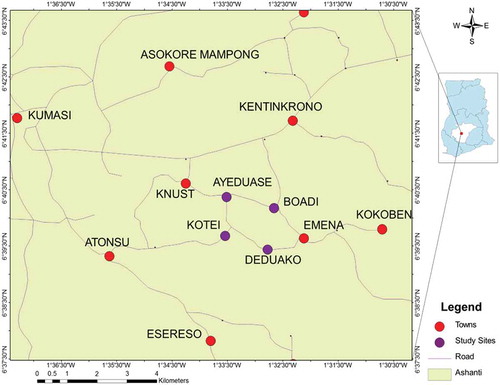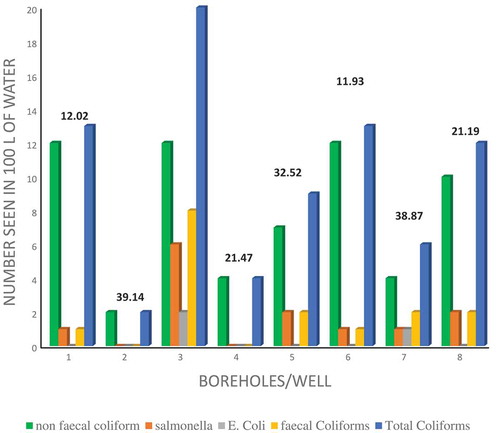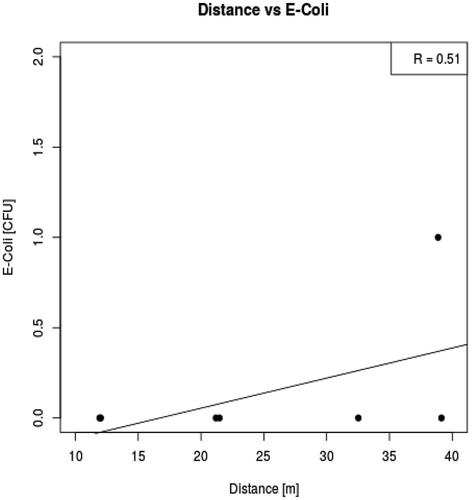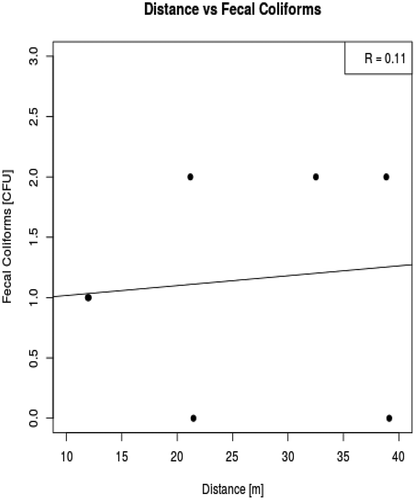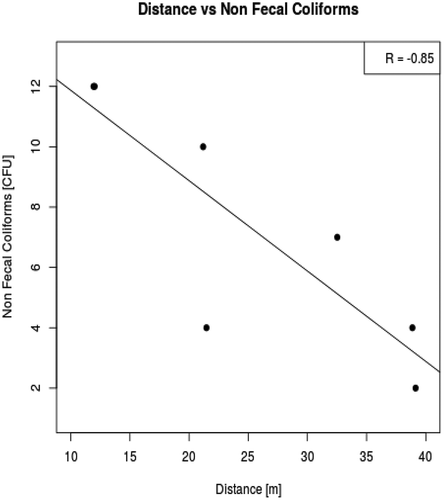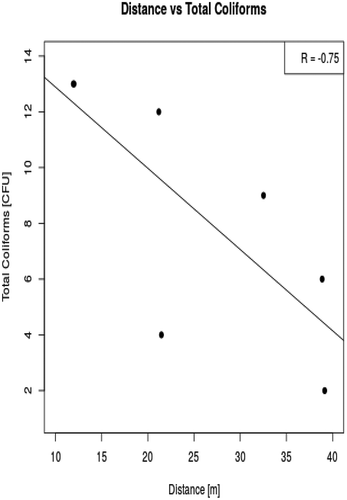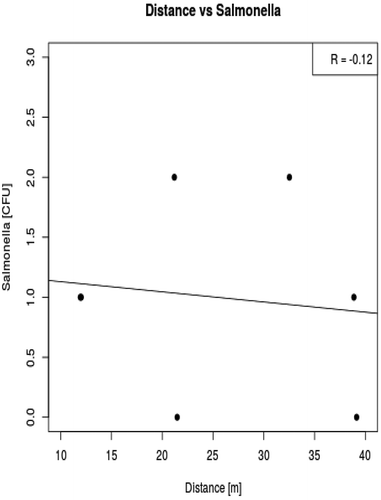Abstract
Water is an indispensable resource to mankind and life in general. Over the world, issues of water scarcity and quality are becoming pronounced with increasing global population, industrialization and urbanization. Developmental activities of man can lead to the deterioration of surface and groundwater. As a result, groundwater has become an important source of water supply throughout the world. This research is very necessary in these communities because of associated cost with purchasing of land due to nearness to the KNUST. The communities serve as residence for students, lecturers and the business community as well. As a consequence, the small pieces of land acquired for building virtually does not give room for considering the siting of septic tanks and underground water, which is the most common source of water in these communities. In this study, water samples were taken from eight purposively sampled wells/boreholes at Ayeduase, Kotei and Boadi communities where septic tanks are within 0–39 m to the well/borehole. However, a control well without septic tank within the radius of above 39 m was chosen. Samples taken from wells were analysed in the laboratory for Escherichia coli, salmonella, faecal coliforms, non-faecal coliforms and total coliforms. E. coli was found present in 25% wells and 25% boreholes sampled. Salmonella and faecal coliforms were found in 75% the boreholes/well except the control well and BH2. Non-faecal coliforms count was 100% in all boreholes/wells. The study reveals that, water in the study communities contain some levels of contaminants and raises questions about its suitability for drinking and domestic use.
PUBLIC INTEREST STATEMENT
The paper examined the levels of microbacterial contamination of groundwater in the study area. It generally looks at the quantum of bacterial coliform levels in groundwater, specifically, in wells/boreholes in the study area. The study then related the levels of the bacterial contaminants to the distance of the groundwater sources from the nearest septic tank. It was realised out of the study that, microbacterial contaminants were present in all the groundwater samples collected in the study area, although in relatively small quantities. These contamination levels were then compared with the World Health Organization guidelines and conclusion were drawn. The study also showed that for non-faecal coliforms and total coliforms count, there was a relationship between distances of wells/boreholes from the septic tanks.
Competing Interests
The authors declare no competing interests.
1. Introduction
According to the World Health Organization (WHO), pathogenic microorganisms are not to be found in drinking water sources (Gorchev & Ozolins, Citation2011). However, in the developing world especially, where a number of the population depends on groundwater, the water sources are vulnerable to contamination from microbacterial sources (Bogena, Citation2015). These contaminations result in high numbers of water contamination-related diseases such as cholera, dysentery, typhoid fever in the developing world, including Ghana (Arshad, Citation2010b). Majority of the microbacterial contaminants come from faecal sources/the gastrointestinal wall of warm-blooded animals, including humans. The presence of microbacterial organisms such as E. coli, and salmonella usually indicate faecal contamination (Odonkor & Ampofo, Citation2013).
Sewage generated from homes in urban area is one of the water quality issues in the world (Water and Sanitation Programme and UNICEF, Citation2015). This sewage, which is usually stored in septic tank, may find their way into groundwater sources and causes contamination (Appling, Habteselassie, Radcliffe, & Bradshaw, Citation2013). The liquid that leaves the septic, known as effluent, contains quite high levels of bacteria and nutrients, including nitrates, chlorides and sulphates, which have the potential to contaminate groundwater. Ghana, a developing country, faces the problem of water supply. The aim of this study is to find bacterial loads in groundwater and examine its relationship with the siting of septic tanks. For the purpose of the study, water samples were taken from eight purposively sampled wells and boreholes within the communities of Ayeduase, Kotei and Boadi in the Ashanti Region. This was done within the early hours of the day, between 5:00 and 8:00 am, when microbial activities are at the minimum. Some of the most common methods used to detect coliform in water, include methods such as the Membrane Filter (MF), the Most Probable Number and the Multiple-Tube Fermentation, employing different techniques with different specific media and conditions for the incubation (Servais, Baudart, & Rompre, Citation2002). There are, however, limitations to these techniques such as taking longer periods of time for incubation, lack of specificity, antagonistic organism interference and the poor specificity in detection of slow growing or Viable but Non-Culturable microorganisms. In this study, MF technique using Chromocult Coliform Agar was employed because it is simple to use and inexpensive. Chromocult Coliform Agar method has the advantage of being able to detect coliforms and E. coli at the same time based on the activity of β-galactosidase and β-glucuronidase enzymes, respectively (Pitkänen et al., Citation2007). CHROMagar contains Rose-Gal and X-Glu (chromogens) for the detection of coliforms and E. coli, respectively (Arshad, Citation2010a). Rose-Gal is usually attacked by β-galactosidase producing a pink coloured colonies (coliforms) (Cappuccino & Sherman, Citation1999). A coliform has the ability to produce both The enzymes β-galactosidase and β-glucuronidase are both produced by E. coli, which act on both substrates to form purple coloured colonies (Servais et al., Citation2002).
2. Materials and methods
2.1. Study area
The study was conducted in Ayeduase, Kotei and Boadi which are all in the Kumasi Metropolitan Assembly (KMA) (Figure ). Kumasi is one of the most populated cities in Ghana, with an estimated population of about 1,730,249 inhabitants (Ghana Statistical Service, Citation2014). The climate zone of KMA is the wet subequatorial type, specifically, the moist semideciduous South-East Ecological Zone. The average temperature within the Metropolis falls between 21.5°C (minimum) and 30.7°C (maximum). Humidity is generally high, averaging around 84.16% at during the day and 60% at night. Ceiba, Triplochlon and Celtis are the most common plant species found in this zone, including other exotic species. The soil here is generally rich in nutrients and good for crop cultivation.
2.2. Sample collection
Eight water samples were purposively collected from four boreholes, three closed wells and one open well in Ayeduase, Kotei and Bodi. The samples were kept sterilized bottles in an ice chest and transported immediately to the laboratory for analysis. Sampling was done between the hours of 5:30 am and 8:30 am.
2.3. Laboratory examination and procedure
The MF technique using Chromocult Coliform Agar was employed. To determine the presence or absence of coliform bacteria, salmonella and E. coli in the water, the Chromocult Coliform Agar was used (Pal, Citation2014). With this method, the water sample was passed through the membrane. This helps to retain the bacteria on the membrane. Filtration is then done and the membrane which contain the bacterial cells is placed on the media for incubation at a temperature of 36 ± 1°C for 24 ± 1 h. When colonies that are salmon to red in colour appear, they are recorded as coliforms, while dark-blue to violet once are as E. coli. Colonies that are also green to turquoise are counted as salmonella. Total coliforms are recorded when salmon to red, dark-blue to violet and turquoise colonies are seen.
With this method, 1 mL of sampled water was added to 99 mL of dilution water. Three serial dilutions with a 99 mL dilution of dilution water and 1 mL of the resulting solutions were performed and the final solution was filtered through a sterile micro pore filter by suction, thereby capturing any coliforms. The Chromocult Coliform Agar was put a Petri dish and the membranes placed aseptically and rolled onto the Chromocult Coliform Agar with the help of sterile forceps. The dish was inverted, closed and incubated at 35°C for 24 h. After incubation is done, the number of salmon to red colonies seen was recorded as coliforms by visual examination, the dark-blue to violet colonies were recorded as E. coli and the sum of these two colonies is recorded as total coliforms
3. Results and discussions
Table presents the total bacterial load in the water samples taken from the four borehole, represent by BH (Borehole); BH1, BH2, BH3, and BH4 and wells, represented as OW (open well) and CW (closed well) in the study communities. CFU/100 denotes coliform forming units per 100 ml of water.
Table 1. Bacterial loads in sampled boreholes (BH), closed wells (CW) and open wells (OW)
Table presents the percentage occurrence of E. coli, faecal coliforms, non-faecal coliforms and salmonella in the water samples collected from the wells and boreholes in the study area.
Table 2. Bacterial isolates in sampled water
Figure is a graphical presentation of the various bacterial contaminants found in each of the wells/boreholes.
3.1. Non-faecal coliforms
This is the most common bacterial contaminant found in relatively higher numbers in groundwater sources in the study area. Non-faecal coliforms were found in all the wells and boreholes sampled. It was also observed that nearness to a septic tank and wells accounted for the highest amounts of the non-faecal coliforms. The closed well (CW2) had few numbers of coliforms because it is the control, with no septic tank around 30–35 m radius. The mere presence of these coliforms in relatively low amounts does not directly mean that the water is contaminated and not fit for domestic and other uses. These results agree with that of Arwenyo, Wasswa, Nyeko, and Kasozi (Citation2017), where the authors found out that the number of coliform counts in open wells and surface water was greater than that in borehole water.
3.2. Salmonella
Salmonella was found to be present in BH1, OW1, CW3, BH3, BH4 and CW4. It was, however, not seen in CW2 and BH2. Again, the OW1 recorded the relative highest amount of salmonella count of 6 CFU/100 ml. Again, this can rightfully be attributed to the fact that the well is an open type and vulnerable to these contaminations. The presence of salmonella in the open wells was generally noted to be higher than in the boreholes (Table ). For drinking water, the WHO guidelines recommend that microbacteria should not be found in any 100 ml of sampled water (Obiri-Danso, Adjei, Stanley, & Jones, Citation2002). In the study area, salmonella was found to be present in 75% of the wells/boreholes sampled.
3.3. E. coli
E. coli is one of the most specific indicators that there is faecal pollution of water than any other faecal coliforms. The WHO guidelines also recommend zero coliform forming units for E. coli in any 100 ml of water for drinking purposes (Adekunle, Adetunji, Gbadebo, & Banjoko, Citation2007).
E. coli count in the study area was generally low, totally absent in BH1, CW2, BH2, CW3, BH3 and CW4. Again, OW1 (the open well) had the highest count of E. coli of 2 and borehole 7 recorded 1 E. coli is an intestinal organism and when found in water, is an indication of contamination from faecal source. Among the wells/boreholes sampled, E. coli was found in just two (25%) and was a little bit higher in the OW1, probably because it is an open well. The well also fell within the unacceptable distance for siting septic tanks from groundwater source. However, no correlation was found between the amounts of E. coli and the distance of septic tanks from the water source. Though its presence is an indication of contamination from faecal source, in this case cannot be linked to the nearest septic tank.
3.4. Faecal coliforms
When the count for the total coliform in a sample is high, and the count for thermotolerant (faecal) coliforms are low or zero, then that result would not necessarily indicate the presence of faecal contamination. It could be attributed to entry of soil or organic matter into the water or by conditions suitable for the growth of other types of coliform (Bartram & Pedley, Citation1996).
Faecal coliforms were absent in the control well, CW2 and BH2. Their presence was however recorded in all the other boreholes and wells, with the OW recording the highest count of 8.
3.5. Effect of septic tank–borehole distance on the various contamination
Figure illustrate the relationship between the levels of bacterial contaminants detected in the well/boreholes in relation to their distances from septic tanks. In Figure , a fairly positive correlation exists between the two variable, with a coefficient of 0.51 (Callaghan, Citation1996), indicating that, as the distance of the well/borehole increase away from the septic tank, the levels of E. coli also increase. This means that distance has no effects on the levels of E. coli in the wells/boreholes.
Figure represents correlation between distance and faecal coliform. Though the correlation is positive with an R value of 0.11, the correlation between the two variables is very weak/negligible.
In Figure , there exist a strong negative correlation between the distance and non-faecal coliform, with an R value of −0.85. This implies that, when the well/boreholes are closer to the septic tank, the non-faecal coliform counts are high.
Figure shows the correlation between distance and total coliform counts. Here again, there exist a fairly strong negative correlation between the two variables. The total coliform count increases as the distance to the septic tank decreases.
Finally, Figure shows the correlation between distance and salmonella counts in the water samples. There exists a very weak negative correlation between the variables with an R value of −0.11.
4. Conclusion and recommendations
From the results of the study, it can be concluded that some levels of microbacterial contaminants were found present in almost all the water samples collected in Ayeduase, Kotei and Boadi communities. The WHO guidelines prescribe that bacterial coliforms are not to be seen in any 100 ml of water for domestic consumption. This implies that, though these coliform bacteria are in small quantity, the water is not wholly safe for drinking purposes. For total coliform and non-faecal coliforms, there exists a strong negative correlation with distance from septic tanks. It can therefore be concluded that, non-faecal coliforms and total coliforms count in groundwater is linked to septic tank pollution. No strong correlation exists between the distances and the other bacterial coliforms.
It is therefore recommended that water quality analysis be carried out on all the boreholes in the district at least once every year to monitor the contaminants that were relatively high or low. Identify the quantity of domestic sewage from septic tanks and other sources that enter into the different groundwater sources in the study area to help improve planning for effective sewage treatment systems and minimizing groundwater pollution by sewage.
Additional information
Funding
Notes on contributors
Jeremiah Kasalku Takal
Jeremiah Kasalku Takal is a young researcher and a candidate for MPhil in Environmental Resources Management. He has done an undergraduate degree in Natural Resources Management and has his major research interest in Natural Resources Management and the Environment. He has a special interest in Agroforestry and has done an unpublished work on the Allelopathic Effects of Neem Leaves Extracts on the Germination and Initial Growth of Vigna unguiculata. He is also currently working on a publication on the use of GIS interpolation to predict the pollution potential of groundwater. This current paper seeks among other things to provide relevant information to policymakers in the Ghanaian water sector on the state of groundwater resources and guide future decisions to satisfy the water needs of the people in the study area.
References
- Adekunle, I. M., Adetunji, M. T., Gbadebo, A. M., & Banjoko, O. P. (2007). Assessment of groundwater quality in a typical rural settlement in Southwest Nigeria. International Journal of Environmental Research and Public Health, 4(4), 307–318.
- Appling, D., Habteselassie, M. Y., Radcliffe, D., & Bradshaw, J. K. (2013). Preliminary study on the effect of wastewater storage in septic tank on E. coli concentration in summer. Water, 5(3), 1141–1151. doi:10.3390/w5031141
- Arshad, M. U. (2010a). Bacteriological analysis of drinking water from 100 families of Lahore by membrane filtration technique and chromagar. Most, 26, 152–156.
- Arshad, M. U. (2010b). Bacteriological analysis of drinking water from 100 families of Lahore by membrane filtration technique and chromagar. Biomedica, 26, 152–156.
- Arwenyo, B., Wasswa, J., Nyeko, M., & Kasozi, G. N. (2017). The impact of septic systems density and nearness to spring water points, on water quality. African Journal of Environmental Science and Technology, 11(1), 11–18. doi:10.5897/AJEST2016.2216
- Bartram, J., & Pedley, S. (1996). Chapter 10 – Microbiological analyses. In J. Bartram & R. Ballance (Eds.), Water Quality Monitoring-A Practical Guide to the Design and Implementation of Freshwater Quality Studies and Monitoring Programmes, UNEP/WHO.
- Bogena, H. (2015). Water and sustainable energy. UN-Water Decade Programme on Advocacy and Communication (UNW-DPAC), 51, 1–6.
- Callaghan, K. (1996). El coeficiente de correlación. Explorations in College Algebra: Discovering Databased Application, (C), 553–557.
- Cappuccino, J. G., & Sherman, N. (1999). Microbiology-A laboratory manual (4th ed., p. 477). Sydney: Addision Wesley Longman, Inc. .
- Ghana Statistical Service. (2014). 2010 population and housing census, district analytical report. Ghana Statistical Service, 1–109.
- Gorchev, H. G., & Ozolins, G. (2011). WHO guidelines for drinking-water quality. WHO Chronicle, 38(3), 104–108.
- Obiri-Danso, K. S., Adjei, B., Stanley, K., & Jones, K. (2002). Microbiological quality and metal levels in wells and borehole water in some peri-urban communities in Kumasi, Ghana. Science and Technology, 3(1), 059–066.
- Odonkor, S. T., & Ampofo, J. K. (2013). Escherichia coli as an indicator of bacteriological quality of water : An overview. Microbiology Research, 4(1), 5–11. doi:10.4081/mr.2013.e2
- Pal, P. (2014). Detection of coliforms in drinking water and its effect on human health - A review. International Letters of Natural Sciences, 17, 122–131. doi:10.18052/www.scipress.com/ILNS.17
- Pitkänen, T., Paakkari, P., Miettinen, I. T., Heinonen-Tanski, H., Paulin, L., & Hänninen, M. L.#x00A0;(2007). Comparison of media for enumeration of coliform bacteria and Escherichia coli in non-disinfected water. Journal of Microbiological Methods. 68(3), 522–529. doi:10.1016/j.mimet.2006.10.007
- Servais, P., Baudart, J., & Rompre, A. (2002). Detection and enumeration of coliforms in drinking water: Current methods and emerging approaches. Journal of Microbiological Methods, 49, 31–54. doi:10.1016/S0167-7012(01)00351-7
- Water and Sanitation Programme and UNICEF. (2015). “Water supply and sanitation in Ghana: Turning finance into services for 2015 and beyond.” World Bank.

